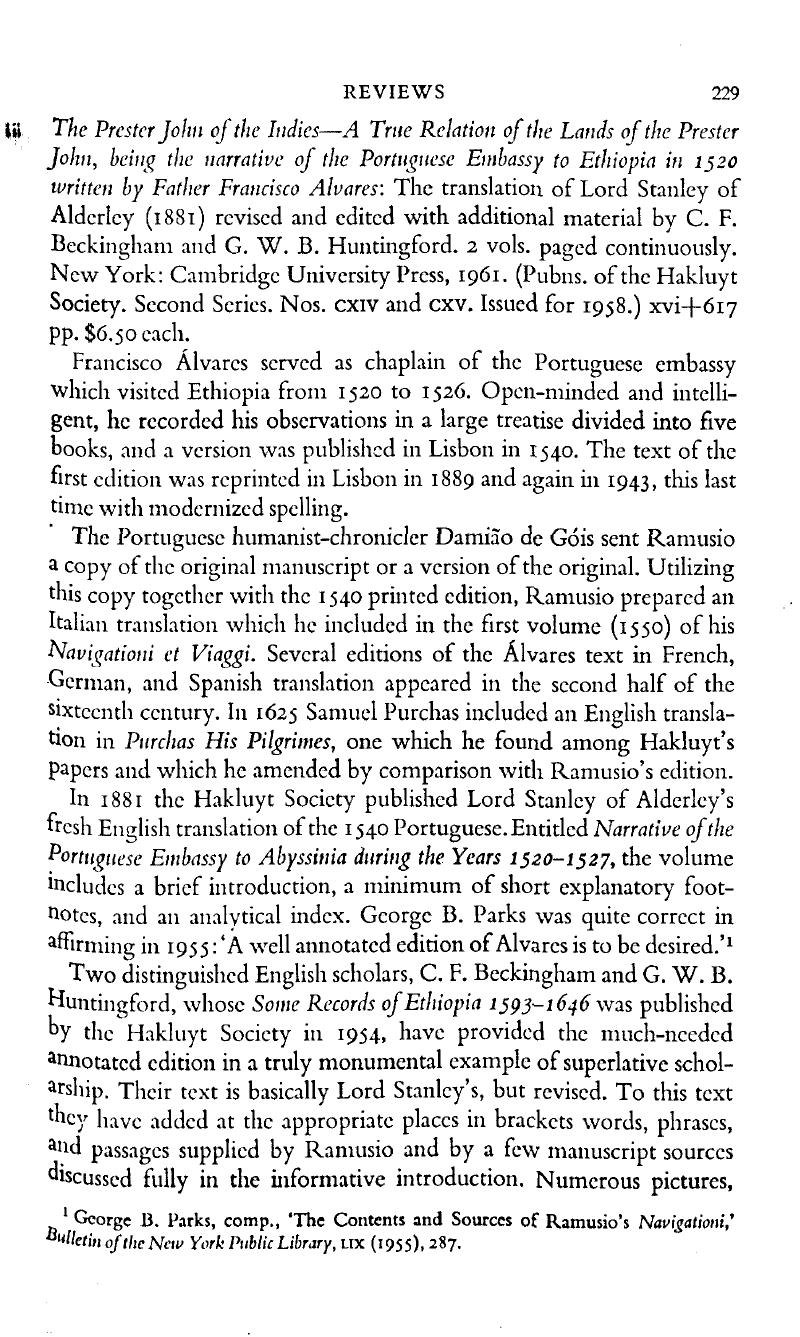No CrossRef data available.
Article contents
The Prester John of the Indies—A True Relation of the Lands of the Prester John, being the narrative of the Portuguese Embassy to Ethiopia in 1520 written by Father Francisco Alvares: The translation of Lord Stanley of Alderley (1881) revised and edited with additional material by C. F. Beckingham and G. W. B. Huntingford. 2 vols, paged continuously. New York: Cambridge University Press, 1961. (Pubns. of the Hakluyt Society. Second Series. Nos. cxiv and cxv. Issued for 1958.) xvi+617 pp. $6.50 each.
Review products
Published online by Cambridge University Press: 20 November 2018
Abstract

- Type
- Reviews
- Information
- Copyright
- Copyright © Renaissance Society of America 1962
References
1 Parks, George B., comp., ‘The Contents and Sources of Ramusio's Navigation,’ Bulletin of the New York Public Library, LIX (1955), 287.Google Scholar.
2 Almagià, Roberto, Contributi alla storia della conoscenza dell'Etiopia (Padua, 1941. “° pp.). [There is an exemplar in the Library of Congress.].Google Scholar
3 Schottus, Andreas, ed., Hispaniae Illustratae seu Rerum Urbiumqiie Hispaniae, Lusistaniae, Aethiopiae et Indiae Scriptores Varii, II (Frankfurt, 1603), 1285-86.Google Scholar
4 Damiani a Goes Equitis Lusitani Opuscula Quae in Hispania Illustrata Continentur (Coimbra, 1791) p.281, 12th line from end, to p. 284, line 19.
5 de Góis, Damião, Opúscules Históricos, tr. Professor Dias de Carvalho (Oporto, 1945) pp. 187–189 Google Scholar. The passage concerning Alvares which is omitted belongs between the next” to-the-last and last lines of p. 188.
6 I discuss these various printed texts in detail in The Quest for Eastern Christians: ‘ ravels and Rumor in the Age of Discovery, scheduled to be published by the University of Minnesota Press in the early autumn of 1962.
7 In the reprinting of the Legatio included on pp. 122-142 of the large Basel compilation of 1533 which opens with the Bellum Christianorum Principum of Robertus Monachus, the supplementary tract is moved from the end to a position immediately following the other account and is entitled ‘De regno Aethiopiac, ac populo, deque moribus eiusdem Populi.’ As Schottus (p. 1286) used this title, it is obvious that on his pp. 1285-88 he rcPrinted pp. 122-127 of the 1533 Basel volume. He next (pp. 1288—1315) reprinted Góis's Fides, Religio, Moresque Aethiopum; he apparently used the 1541 Paris edition of the fides, and not the original 1540 Louvain edition, for on p. 1288 he included an ‘Approbatio’ dated Louvain, July 12, 1541, which is curiously not in the Harvard exemplar of the 1541 edition. On the upper half of p. 1301, however, he interrupted his reprinting of the Góis volume to include the last page (p. 142) of the Legatio as printed in the 1533 Basel compilation. He did not include pp. 128-141 of the Basel volume, namely, the text of the four letters from Emperor Lebna Dengel (David 11) of Ethiopia to Kings Manuel and João in of Portugal and Pope Clement VII, for these letters were an integral part of the Fides and he therefore automatically included them, pp. 1293-1300.
To sum up, the editor of the 1533 Basel compilation rearranged the order of the contents of the original Legatio Dauíd Aethiopiae Regis. Schottus intermixed the contents of the Basel volume and the contents of Damião de Góis's Fides, Religio, Moresque Aethiopum. The editor of the 1791 Coimbra book attempted his own rearrangement of the Schottus synthesis, and the 1945 Oporto volume has transmitted a very complicated textual problem to modern readers of Portuguese.




